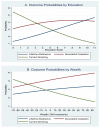Education and smoking: confounding or effect modification by phenotypic personality traits?
- PMID: 20049661
- PMCID: PMC2820130
- DOI: 10.1007/s12160-009-9142-3
Education and smoking: confounding or effect modification by phenotypic personality traits?
Abstract
Background: Little is known about whether educational gradients in smoking patterns can be explained by financial measures of socioeconomic status (SES) and/or personality traits.
Purpose: To assess whether the relationship of education to (1) never smoking and (2) having quit smoking would be confounded by financial measures of SES or by personality; whether lower Neuroticism and higher Conscientiousness would be associated with having abstained from or quit smoking; and whether education effects were modified by personality.
Method: Using data from the Midlife Development in the US National Survey, 2,429 individuals were classified as current (n = 695), former (n = 999), or never (n = 735) smokers. Multinomial logistic regressions examined study questions.
Results: Greater education was strongly associated with both never and former smoking, with no confounding by financial status and personality. Never smoking was associated with lower Openness and higher Conscientiousness, while have quit was associated with higher Neuroticism. Education interacted additively with Conscientiousness to increase and with Openness to decrease the probability of never smoking.
Conclusions: Education and personality should be considered unconfounded smoking risks in epidemiologic and clinical studies. Educational associations with smoking may vary by personality dispositions, and prevention and intervention programs should consider both sets of factors.
Figures



Similar articles
-
Personality and smoking: individual-participant meta-analysis of nine cohort studies.Addiction. 2015 Nov;110(11):1844-52. doi: 10.1111/add.13079. Epub 2015 Aug 22. Addiction. 2015. PMID: 26227786 Free PMC article.
-
Smoking Status and the Five-Factor Model of Personality: Results of a Cross-Sectional Study Conducted in Poland.Int J Environ Res Public Health. 2017 Jan 27;14(2):126. doi: 10.3390/ijerph14020126. Int J Environ Res Public Health. 2017. PMID: 28134805 Free PMC article.
-
A social-contextual investigation of smoking among rural women: multi-level factors associated with smoking status and considerations for cessation.Rural Remote Health. 2018 Mar;18(1):4338. doi: 10.22605/RRH4338. Epub 2018 Mar 4. Rural Remote Health. 2018. PMID: 29500916 Free PMC article.
-
Socioeconomic disparities in quit intentions, quit attempts, and smoking abstinence among smokers in four western countries: findings from the International Tobacco Control Four Country Survey.Nicotine Tob Res. 2010 Oct;12 Suppl(Suppl 1):S20-33. doi: 10.1093/ntr/ntq051. Nicotine Tob Res. 2010. PMID: 20889477 Free PMC article.
-
Smoking Cessation After Acute Myocardial Infarction in Relation to Depression and Personality Factors.Int J Behav Med. 2016 Apr;23(2):234-42. doi: 10.1007/s12529-015-9514-y. Int J Behav Med. 2016. PMID: 26475034
Cited by
-
Big Five Personality and CTRA gene expression: Lack of association in a midlife sample of US adults (MIDUS-Refresher).Pers Individ Dif. 2021 Feb 1;169:109908. doi: 10.1016/j.paid.2020.109908. Epub 2020 Feb 28. Pers Individ Dif. 2021. PMID: 33716369 Free PMC article.
-
Trends in Health Behavior of Polish Women in 1986-2021: The Importance of Socioeconomic Status.Int J Environ Res Public Health. 2023 Feb 23;20(5):3964. doi: 10.3390/ijerph20053964. Int J Environ Res Public Health. 2023. PMID: 36900975 Free PMC article.
-
Personality and physical functioning among older adults: the moderating role of education.J Gerontol B Psychol Sci Soc Sci. 2013 Jul;68(4):553-7. doi: 10.1093/geronb/gbs094. Epub 2012 Oct 15. J Gerontol B Psychol Sci Soc Sci. 2013. PMID: 23070900 Free PMC article.
-
The associations of personality traits and parental education with smoking behaviour among adolescents.PLoS One. 2017 Mar 23;12(3):e0174211. doi: 10.1371/journal.pone.0174211. eCollection 2017. PLoS One. 2017. PMID: 28333969 Free PMC article.
-
Culture, inequality, and health: evidence from the MIDUS and MIDJA comparison.Cult Brain. 2015;3(1):1-20. doi: 10.1007/s40167-015-0025-0. Epub 2015 Jan 21. Cult Brain. 2015. PMID: 25750852 Free PMC article.
References
-
- World Health Organization . The world health report 2002: Reducing risks, promoting healthy life. World Health Organization; Geneva: 2002. - PubMed
-
- Pierce JP, Fiore MC, Novotny TE, et al. Trends in cigarette-smoking in the united-states - educational-differences are increasing. JAMA. 1989;261(1):56–60. - PubMed
-
- Droomers ML, Schrijvers CTM, Mackenbach JP. Why do lower educated people continue smoking? explanations from the longitudinal GLOBE study. Health Psychology. 2002;21(3):263–72. - PubMed

